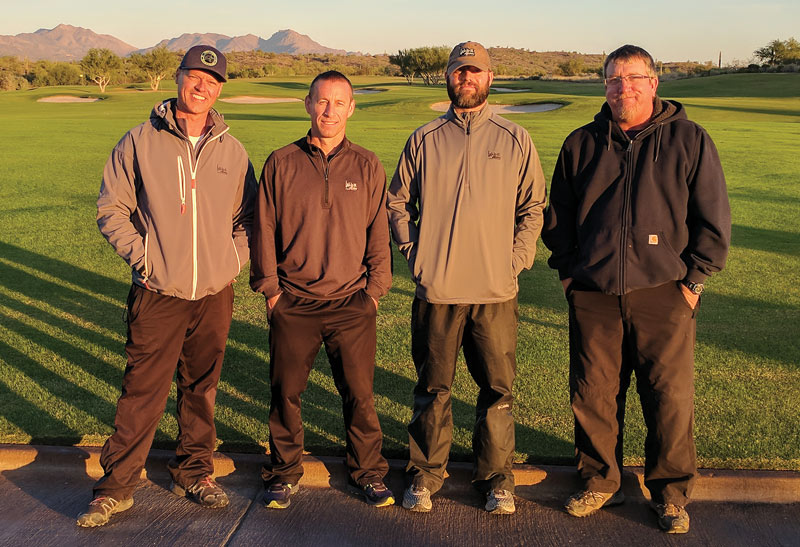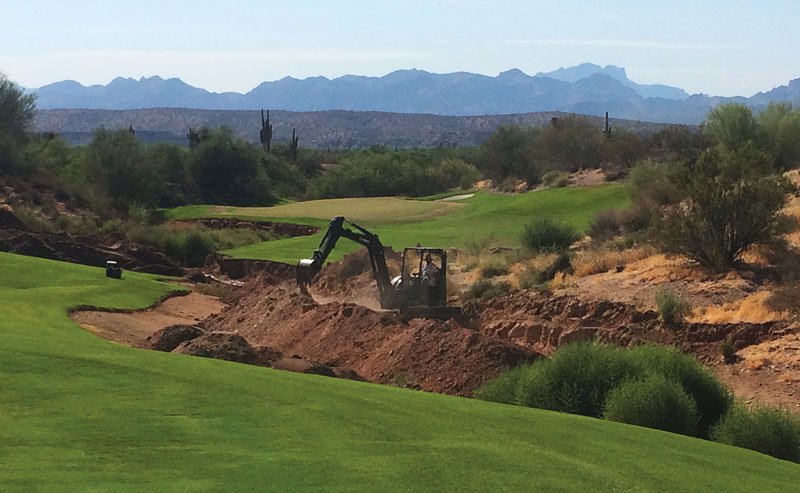
A recent renovation effort at We-Ko-Pa Golf Club in Fountain Hills, Ariz., gave director of maintenance Ryan Kreizenbeck the opportunity to have a go at golf course design on the par-5 eighth hole on the club’s Cholla course. The final results of that work are shown here. Photos courtesy of Ryan Kreizenbeck
They’re not fitting Ryan Kreizenbeck for a Ross tartan sport coat just yet, but the veteran superintendent at We-Ko-Pa Golf Club in Fountain Hills, Ariz., just outside Scottsdale, has successfully completed his first renovation job. Despite Kreizenbeck’s newly expanded résumé, though, Scott Miller’s and Bill Coore’s jobs remain safe.
“I’m not planning to get into the business of designing or redesigning entire golf courses — I’m not qualified to do that,” says Kreizenbeck, the GCSAA Class A director of maintenance at the 36-hole resort facility, where he has been at the reins since its opening in 2001. “But this project was pretty straightforward. We knew what needed to be done and how we needed to do it, so we didn’t really think it was necessary to get an architect involved. Scott Miller designed a wonderful golf course here. However, with any great golf course, there will be tweaks made over time.”
The tweaks Kreizenbeck oversaw were part of a larger renovation accomplished with assistance from contractor Landscapes Unlimited during summer 2016, which is the off-season in the desert. Miller had indeed designed the first course at We-Ko-Pa, the Cholla, which is the older of the property’s two tracks (the Saguaro, designed by Coore and Crenshaw, was built five years later). After 15 years, the time had come to freshen up the Cholla.
The lion’s share of the work involved regrassing all greens with MiniVerde bermudagrass, replacing the sand in all bunkers, installing new irrigation heads and controllers, and decreasing the turfgrass footprint by approximately 7 acres. Tifway bermudagrass had infiltrated the greens over the years, and the bunker sand was no longer moving water through the profile because of contamination from organic matter and fine materials. As Kreizenbeck puts it, “It was primarily a matter of returning the golf course to great playing conditions after 15 years of aging.” While there were a few areas where turf was added — three green surrounds were slightly enlarged to improve irrigation efficiency, achieved by eliminating several smaller sprinkler heads and replacing them with one or two larger heads — the overall reduction in turf was something We-Ko-Pa management had deemed necessary for water conservation purposes.
The Cholla course: Eight is enough
The most significant addition — the one that qualifies Kreizenbeck’s work as a proper “redesign” project — took place on the Cholla’s par-5 eighth hole. A major modification had long been in order for the hole, Kreizenbeck says, and the 2016 initiative was the time to tackle it.

The management team for the maintenance department at We-Ko-Pa Golf Club consists of (from left to right) Scott Biegen, assistant superintendent; Ryan Kreizenbeck, director of maintenance; Matt Black, superintendent of the Saguaro course; and Greg Pecenka, superintendent of the Cholla course.
“Addressing the eighth hole was something we’d talked about doing since the first year we were open,” says the 25-year GCSAA member. “Basically, there used to be a wash that ran diagonally across the hole, right where you’d want to land your second shot. It’s a long, downhill hole — close to 600 yards. The problem was there wasn’t a layup area between 100 to 150 yards. Unless you were a really good player who could hit it long and straight, the best way to play the hole was to lay up to about 170 yards on the second shot, and then you were left with a very challenging shot into a well-guarded green.
“The good thing about the hole was that everyone talked about it. It was definitely a memorable hole. Unfortunately, almost everyone complained about it. We finally decided that we had an opportunity to do something about it, so we did.”
To Kreizenbeck, the solution was clear and simple: Pipe the wash, fill in the wash area to elevate the grade, and tie it all in to the surrounding landforms. “The intent was to create a second-shot landing area where a golfer could have a short iron into the green for the third shot,” Kreizenbeck says. “The changes we planned weren’t going to have a huge impact on the hole for better players pulling out a 3-wood and going for the green in two. Our hope was that we would make it easier and more fun to play for the vast majority of our golfers by giving them more options on the layup. We didn’t expect to turn pars into birdies, but hopefully we’d turn 8s into 6s.”
Along with making the eighth hole more enjoyable, Kreizenbeck was also looking to influence pace of play. “A typical busy day on the Cholla course would normally result in several groups backed up on that hole,” Kreizenbeck says. “The driver/7-iron/7-iron sequence was probably the smartest approach to managing the hole, but I think it was difficult, especially for golfers playing the hole for the first time, to embrace this unconventional strategy.” The toll was lots of balls lost in the desert, and lots of time spent searching for them.
Timing and teamwork at We-Ko-Pa
The scope of the work completed on the eighth hole covered only about an acre of land. “We piped the wash, hauled in some fill, made a cut on the right hillside to bring in some more fill, did a little shaping to tie it all in, and grassed it,” says Kreizenbeck, adding that he didn’t prepare any drawings. “It was really a collaborative effort on the ‘design’ aspect, between me, the dozer operator and the superintendent from Landscapes.”

Filling in a wash that previously ran diagonally across the hole so that a new landing area could be created was one of Kreizenbeck’s primary objectives as he guided renovation on the Cholla’s No. 8.
The greatest challenge, in Kreizenbeck’s view, may have simply been finding the time to do all the work on the eighth hole, and then finishing the work with enough time for grow-in. “We had all this other stuff going on at that time — the regrassing and the sand replacement, all the irrigation work. I certainly didn’t get it done on my own.” Kreizenbeck says Cholla course superintendent Greg Pecenka, an 18-year GCSAA member, and his assistant, Scott Biegen, a six-year association member, played a vital role in bringing the renovation work to fruition, while Saguaro superintendent Matt Black, a nine-year GCSAA member, ramped up his efforts on the Saguaro given that Kreizenbeck’s time there was limited. On top of that, “The superintendent from Landscapes couldn’t have been better to work with,” Kreizenbeck says.
That Landscapes Unlimited project superintendent was Jose Francisco Jauregui Rodriguez, who says handling regrassing and bunker sand replacement jobs without the input of a course architect isn’t terribly uncommon. It’s even routine, he says, to identify and solve water flow issues on greens during a regrassing. “There’s a lot we’ll do directly with a superintendent, as long as it doesn’t affect grades or contours,” Rodriguez says. “Once you get into grades and contours, you need to get an architect in there.”
While their activity on the eighth hole of the Cholla did in fact involve contouring, Rodriguez says it worked out well. “Ryan was focused on every detail, and was totally prepared to get that work done,” he says. “He had all the information I needed to get going. I didn’t have to come up with any ideas, and we only used about 700 cubic yards of soil, which we found elsewhere on-site. It looks great today and plays great. It solved a turf issue, too, because the old second-shot landing area had been collecting too many balls in the same spot.”
Not his first rodeo
Kreizenbeck didn’t embark on this design and construction venture entirely green. He’d arrived in Arizona after stints as superintendent at three separate courses managed by OB Sports, including one — Trophy Lake Golf and Casting Club in Bremerton, Wash. — where he’d participated in the construction process. He was also on the job for the construction of both the Cholla and Saguaro courses at We-Ko-Pa.
Throughout his 16 years in Fountain Hills, Kreizenbeck also had plenty of occasions to carry out small jobs with his crew, such as building new tees — something that didn’t exactly involve contouring. “Adding tees out here is a pretty straightforward process, because there’s so much land. If you want to extend a hole or change an angle, you can do it,” Kreizenbeck says. “After a few years here, we decided there were better shot angles to be had out there on a couple of holes, and a couple other holes just needed more distance.”
Even though the adjustments to the Cholla’s eighth hole were a departure from those previous pursuits, the execution was similar in its smoothness. “If we weren’t confident about what needed to be done and our ability to get it done, we would have involved an architect,” Kreizenbeck says. “The way we went about it proved to be very effective with a tight budget and timeline. Jose and I were both out there all day almost every day, so decisions could be made very quickly without holding up progress.”

Refinements to the Cholla’s eighth hole required only about 700 cubic yards of soil, and have helped improve pace of play on the layout by nearly 10 minutes per round.
How has Kreizenbeck’s handiwork been received? “The feedback has been almost entirely positive,” he says. “According to our head pro, the front nine plays almost 10 minutes quicker than it used to, and I think that has everything to do with the changes we made on No. 8. This is a big deal from an operational standpoint, especially since the Cholla course normally plays 15 to 20 minutes slower than the Saguaro. Getting people around the course quicker always makes them happier.”
And while dabbling in design offered a nice, rewarding break from his typical course maintenance duties, Kreizenbeck says his greatest point of pride regarding the project was that all renovation and grow-in work was completed in such a short time frame — and under budget. “Everyone worked together with the same common goal, and we were able to reopen the golf course in mid-September (2016) to capture three weeks of revenue before we closed for overseed,” Kreizenbeck says. He also commends the Fort McDowell tribal nation, which owns and operates We-Ko-Pa, for reinvesting in the Cholla course to uphold its standing in a highly competitive golf market.
Hal Phillips is the managing director of golf and resorts for Mandarin Media, a public relations firm with offices in Portland, Maine; Park City, Utah; and Saigon, Vietnam. He is the former editor of Golf Course News.